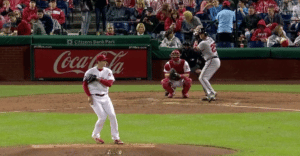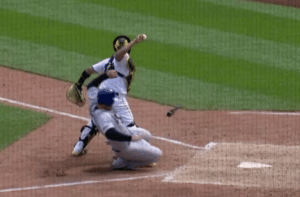11 Rules Questions that Need Answering Now
-
If a manager wants to challenge multiple situations in the same play, what is the proper way to have the field umpires communicate this to the Command Center?
The manager should tell the field umpires the situations he wants challenged. It should be done in layers at the same time.
-
Does a tag attempt have to be completed for the runner’s baseline to be restricted?

The tag attempt iscompleted the moment the fielder with ball in glove or ball in hand makes movement toward the runner. It is at that moment that the runner has a restricted baseline. It is an imaginary line to the base he is going to and he cannot exceed three-feet to either side of that line. It is always umpire’s judgment whether or not the runner exceeds his three-foot limit. And it’s a play that can’t be reviewed.
The Cards hosted the Phils on May 17. In the bottom of the third the Cards had Francisco Pena on second base and one out when Tommy Pham hit a ground ball to Maikel Franco at third base. Pena advancing from second to third attempted to avoid Franco’s tag and was ruled out for going out of the baseline. You can make your own call on this play.
https://www.mlb.com/video/phillies-turn-double-play/c-2053515083?tid=6479266
-
There’s a left- handed pitcher on the rubber with runners on second and third. The pitcher is in the set position but has not yet taken the sign from the catcher. The pitcher flips the ball from his glove to his hand. Is that a balk?
I don’t think every umpire would call it, but it would be wise not to take the chance. That’s a bad habit that should be corrected.
-
A runner is stealing third base. Can a right-handed pitcher pick-up his left leg without disengaging the rubber?

Yes, but he should make a continuous motion to the base.
-
American League game or inter-league game in an AL stadium. If Jones begins the game as the starting pitcher, can he in some later inning pinch hit for the DH and stay in the game as the pitcher?
The game pitcher may pinch-hit or pinch-run only for the DH. Either way he assumes that position in the batting order and the DH role is terminated the rest of the game.
-
The pitching coach comes out to talk to the pitcher with Joe Smith at bat. As the pitching coach is headed back to the dugout, the manager of the team at bat puts in a pinch-hitter. Can the manager of the defensive team come back out and remove the pitcher or does the pitcher have to pitch to the pinch-hitter?
The manager or coach is prohibited from making a second visit to the mound while the same hitter is at bat, but if a pinch-hitter is substituted for the batter, the manager or coach may then make a second visit to the mound, but must then remove the pitcher. For the purpose of this rule, a batter’s time at bat begins the moment the preceding batter is put out or becomes a runner.
-
If a thrown or a batted ball makes contact with unattended equipment on the playing field, is the ball in play?
For safety reasons, teams are encouraged to keep playing equipment off the field. It’s possible that a throw to the plate might make contact with the bat that was used in the play. If that should occur, the ball remains in play. It’s a good idea for the catcher or the umpire to keep the house clean by throwing the bat a safe distance from the play.
-
The batter hit a ball in the left center field gap. The umpire calls catcher’s interference on the catcher. How should this be handled? Is the ball dead immediately?
The ball is dead only if the batter fails to make contact with the ball or in making contact, he hits a foul ball. When catcher’s interference is called under rule 5.05 (b) (3), the batter is awarded first base. Runners on base advance only if forced. The interference is nullified if the batter and all runners advance at least one base on the play. In the case where catcher’s interference is called with no runners on base, if the batter advances at least one base, the interference is nullified. If the batter is thrown out at second or any other base, he is out. If the batter-runner rounds first base and the fielder throws behind him and he is tagged-out, the out remains. If the ball is put in play and all runners, including the batter-runner, do not each advance one base following a catcher’s interference call, the manager of the offensive team may elect to take the play and forego the penalty.
The Cubs’ Tommy La Stella reached base twice in Thursday’s game against the Phils because Phils’ catcher Andrew Knapp interfered with him. A more detailed report will follow. See link below.

https://www.mlb.com/video/la-stella-on-by-2-interferences/c-2129286283?tid=6479266
-
The runner is stealing second base. The catcher attempts to throw out the runner but the batter swings and misses and his momentum interferes with the catcher’s throw. The batter’s backswing then makes contact with the catcher. What’s the call?
Batter interference. The batter is out unless the catcher retires the runner. If it is strike three, both the batter and the runner are out. The backswing becomes irrelevant because the batter interfered with the throw prior to the backswing interference. If only backswing interference was called, the batter would remain at bat unless it was strike three. The runner would be returned to first base unless he was put out.
-
Three runners cross the plate on the same play. The first runner misses the plate before the following runners touch the plate. Can the first runner return to touch the plate after either of the following runners has scored? Is this an appeal play? Can passing the runner be called?
When a runner misses the plate, he cannot return to touch the plate if a following runner/s scores. However, this is an appeal play since it is always assumed that a runner touches a base until appealed. The passing the runner rule does not apply here.
-
In the recent Rizzo illegal slide to the plate, if he made the same slide at second base, would he be called out?

A runner is not allowed to deviate or change direction in his pathway to a base for the purpose of initiating contact with a fielder. This is true for both rule 6.01(j) “Sliding to Bases on Double Play Attempts” and rule 6.01 (i), “Collisions at home plate.”
In 2016 the MLB Players Association issued several clarification points regarding the slide rule, one of which is “Veering for Contact.” It reads, “If the runner clearly changes direction in an effort to make contact with the pivot man, it shall be called a violation.” This was sent directly to me by MLB. The language in the Official Baseball Rules that comes closest is found in 6.01 (j) (4). It reads, “A “bona fide slide” for the purposes of Rule 6.01 occurs when a runner slides within reach of the base without changing his pathway for the purpose of initiating contact with a fielder.”
In my opinion, the “Veering for Contact” language parallels the language in 6.01 (i) that reads , “ A runner attempting to score may not deviate from his direct pathway to the plate in order to initiate contact with the catcher (or other player covering home plate), or otherwise initiate an avoidable collision.

